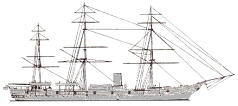
NAVYPEDIA
 Support the project with paypal
Support the project with paypal
Photo

Emerald 1878
Ships
| Name | No | Yard No | Builder | Laid down | Launched | Comp | Fate |
|---|---|---|---|---|---|---|---|
| Opal (ex-Magicienne) | 63 | Doxford, Sunderland | 13.10.1873 | 9.3.1875 | 1.1876 | sold 8.1892 | |
| Tourmaline | 113 | Raylton Dixon, Middlesborough | 17.7.1874 | 30.10.1875 | 25.10.1876 | coal hulk 1899 | |
| Turquoise | 203 | Earle, Hull | 8.7.1874 | 22.4.1876 | 13.9.1877 | sold to BU 9.1892 | |
| Ruby | 202 | Earle, Hull | 8.7.1874 | 9.8.1876 | 14.6.1877 | coal hulk 12.1904 | |
| Emerald | 190 | Pembroke DYd | 29.7.1874 | 18.8.1876 | 2.7.1878 | powder hulk 1898 | |
| Garnet | Chatham DYd | 16.3.1875 | 30.6.1877 | 31.10.1878 | sold 12.1904 |
Technical data
| Displacement normal, t | 2120 |
|---|---|
| Displacement full, t | |
| Length, m | 67.1 pp |
| Breadth, m | 12.2 |
| Draught, m | 5.48 |
| No of shafts | Garnet: 1 (feathering screw) others: 1 (hoisting screw) |
| Machinery | sails + 1 2-cyl HCE, 6 cylindrical boilers |
| Power, h. p. | Opal: 2187 Turquoise: 1994 Ruby: 1833 Tourmaline: 1972 Emerald: 2170 Garnet: 2005 |
| Max speed, kts | Opal: 12.5 Turquoise, Ruby: 12.3 Tourmaline: 12.6 Emerald: 13.9 Garnet: 13.2 |
| Fuel, t | coal 260 |
| Endurance, nm(kts) | 2000 - 2280(10) |
| Armament | Opal: 12 x 1 - 160/16 64pdr 71cwt MLR, 2 x 1 - 160/16 64pdr 64cwt MLR others: 10 x 1 - 160/16 64pdr 71cwt MLR, 2 x 1 - 160/16 64pdr 64cwt MLR |
| Complement | 232 |
Standard scale images

Emerald 1878
Graphics
Project history
Designed by Nathaniel Barnaby. The introduction of the steel-hulled despatch vessels Iris and Mercury, with a speed of 18kts, made all other materials for hull construction obsolete, so the period of composite construction was brief. Care had to be taken in the distribution and support of weights in wooden hulls, to avoid excessive hogging and sagging. In composite hulls, the additional longitudinal strength gave designers more freedom in hull lines and weight distribution The theory that a fine entry gave extra speed was influenced by the performance of tea clipper ships with their 'Aberdeen bow', ie extending the stem out to form a cutwater, drawing the waterlines finer at the bow, giving greater buoyancy forward and enabling the ship to divide the water easily. In practice, however, this theory did not work with the Emerald class. To compensate for buoyancy they were given a short but very full midships section. Receiving little help from the ends, they tended to behave like a see-saw in heavy weather. Their faulty underwater lines adversely effected their performance under sail, none exceeding much more than 12kts. The frames and keels of this class were of wrought iron and the stem and stern post of cast iron. The cladding was a double layer of teak, the inner 89mm, the outer 76mm in thickness. The first layer of timber was secured direct to the frames, the second to the first with a waterproof coating between. Watertight bulkheads extended to the upper deck. The compound engines were far from satisfactory due to the Admiralty's decision to invite competitive tenders, resulting in price cutting and inferior workmanship. In fact, the engine in Tourmaline was so troublesome that her chief engineer suffered a nervous breakdown, committing suicide. The HCE engines were of two cylinders - one HP and one LP. The six cylindrical boilers worked at 4.2kgf/cm2. All guns were slide-mounted, with a broadside fire of five a side and two chase guns firing through embrasures at both ends of the ship. As completed they were all ship-rigged, carrying 1700m2 of plain sail. The lower masts were of iron.
Opal was laid as Magicienne and renamed 12.2.1875.
Modernizations
1876, Opal: - 2 x 1 - 160/16
early 1880s, Emerald, Tourmaline: were rearmed with 4 x 1 - 152/26 BL Mk II, 8 x 1 - 127/25 BL Mk I/II/III/IV/V
early 1880s, Garnet: was rearmed with 14 x 1 - 127/25 BL Mk I/II/III/IV/V
1880s, all: were converted to barque rig; + (7 - 9) x 1 - 11.4/87
Naval service
No significant events.
Many thanks to Wolfgang Stöhr for additional information on this page.
 HOME
HOME FIGHTING SHIPS OF THE WORLD
FIGHTING SHIPS OF THE WORLD UNITED KINGDOM
UNITED KINGDOM CRUISERS
CRUISERS EMERALD composite screw corvettes (6, 1876 - 1878)
EMERALD composite screw corvettes (6, 1876 - 1878)
